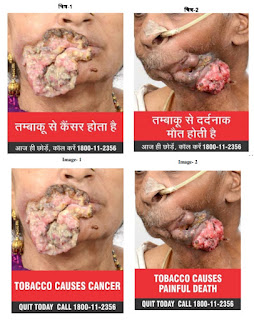 On the 26th April, Dr Balram Bhargava, the newly appointed director general of Indian Council of Medical Research (ICMR), the apex body for medical research in India, said that the government must take steps to contain the growing consumption of tobacco through measures as aggressive as those used to fight tuberculosis in the country. He also suggested that all medical colleges must have tobacco cessation clinics – small set up with doctors from surgery, cardiology, psychiatry and dentistry – and those which don't have such clinics, must be de-recognised and higher taxation should be imposed on tobacco, along with sugar and trans fats. He also highlighted the burden of the problem in India and neighbouring countries in South East Asia such as Bangladesh, Myanmar, Sri Lanka and others.
On the 26th April, Dr Balram Bhargava, the newly appointed director general of Indian Council of Medical Research (ICMR), the apex body for medical research in India, said that the government must take steps to contain the growing consumption of tobacco through measures as aggressive as those used to fight tuberculosis in the country. He also suggested that all medical colleges must have tobacco cessation clinics – small set up with doctors from surgery, cardiology, psychiatry and dentistry – and those which don't have such clinics, must be de-recognised and higher taxation should be imposed on tobacco, along with sugar and trans fats. He also highlighted the burden of the problem in India and neighbouring countries in South East Asia such as Bangladesh, Myanmar, Sri Lanka and others.
“I am planning to raise these issues with the prime minister, I have sought an appointment with him. I will probably be meeting him next week,” Dr Bhargava said, speaking at the National Institute of Cancer Prevention and Research (NICPR) for the release of a report brought out by the WHO Framework Convention for Tobacco Control and NICPR, recommending the ban on manufacturing, selling and importing smokeless tobacco products which include pan masala, gutka, and khaini. The report also throws light on the global progress made in implementing smokeless tobacco control policies as these products have posed a grave challenge to public health in the country.
Dr Bhargava, a former professor of cardiology at AIIMS, said that heart attacks have hit those in their early 40s too, "even when there is no history of diabetes or hypertension, and it is all because of tobacco use.” Dr Ravi Mehrotra, director, NICPR, spoke about the opening of India’s first tobacco testing laboratory next month. The laboratory will be the first-of-its-kind set up which will be equipped to detect and quantify tobacco content in products sold in the market, he said. Other such laboratories are in Netherlands and in Atlanta. NICPR is also now a global hub for smokeless tobacco research.
According to the latest Global Adult Tobacco Survey India Report 2016-17 (GATS), which is a global standard for systematically monitoring adult tobacco use (smoking and smokeless) and tracking key tobacco control indicators, 199.4 million of all adults currently use smokeless tobacco in India and 49.6 per cent of current smokeless tobacco users are planning or thinking of quitting smokeless tobacco use. A 2010 study estimated that more than 36,800 deaths were attributable to smokeless tobacco use in the country. To address the issue, the government has joined hands with WHO-FCTC Secretariat and set up a global knowledge hub on Smokeless Tobacco (KH-SLT) at the ICMR-NICPR, Noida.

